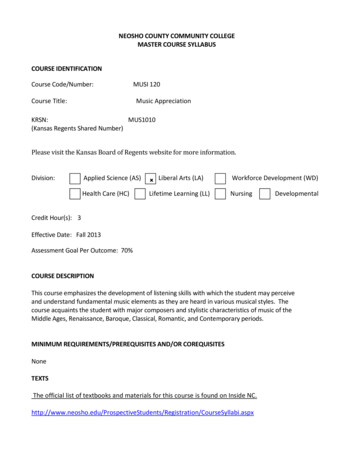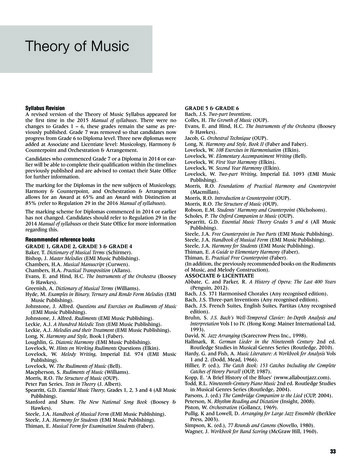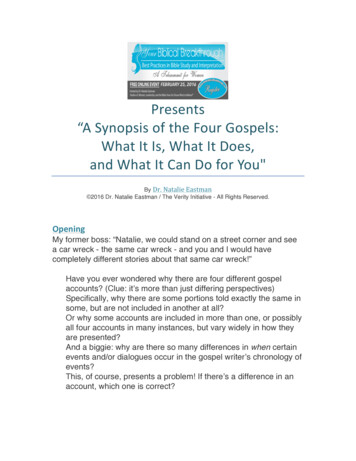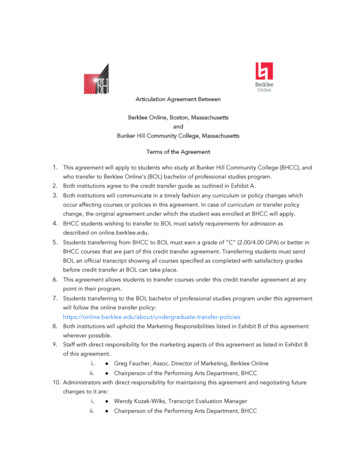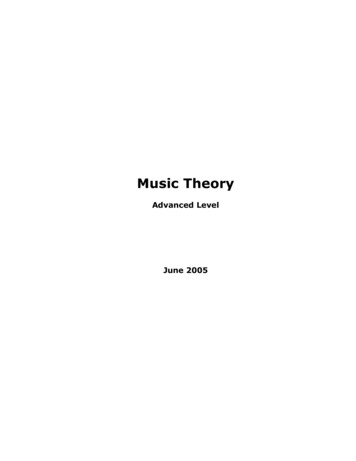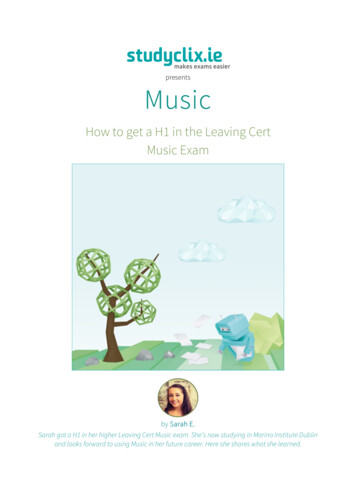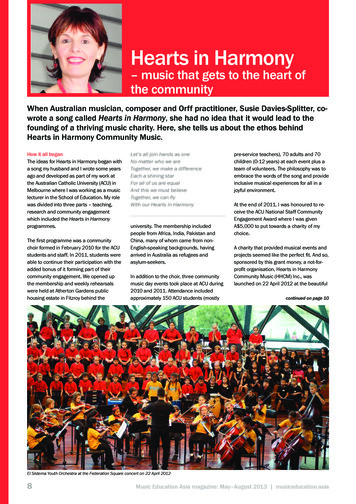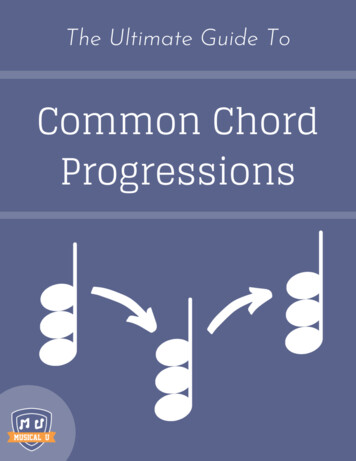
Transcription
Harmony in Western music would not exist without chordprogressions - much of Western music, especially pop, rock,blues, jazz, and classical, is built on sequences of chords.Creating a chord progression may be easy, but not all chordcombinations sound good together, and if you created one at random,it’s unlikely that it would sound memorable or satisfying.If you’re trying to write the “perfect” chord progression, bad news someone has beat you to it, and countless other someones havewritten songs based around this earworm of a chord progression.Listen to a medley of songs based around this progression1This particular progression is known as the I – V – vi – IV, and it’s noaccident that thousands of songwriters have used it to great effect it’s been described as a progression that sounds satisfying, hopeful,complete, and sentimental.It turns out, there’s a whole stack of these common chordprogressions that gained their fame through their strong senseof purpose, direction, and resolution.Stay with us as we take you through a bit of theory to explain wherethese chords come from, look at the most popular ways in whichthey’re strung together, and explore how you can use theseprogressions to write your own unique tune without falling into thetrap of music cliché.1https://www.youtube.com/watch?v HTYrkOZ5nCs1 Copyright Musical U, https://www.musical-u.com/
TABLE OF CONTENTSA Bit of TheoryScales and ChordsNaming Progressions444What makes a chord progression sound good?A Path to ResolutionA Natural Order556Popular Chord ProgressionsThe Popular Kid: I-IV-V ProgressionI – IV – V in every key:The 12-Bar BluesThe Sensitive One: I – V – vi – IV ProgressionI – V – vi – IV in every key:The Jazz Cat: ii – V – I Progressionii – V – I in every key:The Canon: I – V – vi – iii – IV – I – IV – V ProgressionI – V – vi – iii – IV – I – IV – V in every key:Further Progressions 778910111112131314Transposing Chord ProgressionsTransposing on PianoTransposing on Guitar151515What makes songs with the same progression sound different?16Melody, Lyrics, and Phrasing17Instrumentation, Tempo, and Genre17Rhythm and Tempo18Writing Songs with Common Chord ProgressionsSongwriting Tools1819One Chord In Front of the Other192 Copyright Musical U, https://www.musical-u.com/
A Bit of TheoryWe know that some chords sound good together, and some. not somuch.So why do some chord progressions pop and others flop?Scales and ChordsTo understand this phenomenon, we turn to the scale .Every major and minor scale has seven pitches, and a chord can bebuilt on each of the seven pitches. These chords are known as diatonicchords , and can be thought of as a family of chords belonging to onekey.Each of these chords follows the key signature of the key, andtherefore there is a lot of note overlap - every chord uses three out ofa possible seven notes, which means that these seven chords tend tosound pretty good together.We can name these seven chords by using numbers:Naming ProgressionsAs you may have figured out, naming a progression is as simple asstringing together the numerals representing the chords you’replaying.Here’s a ii – V – I in C major:3 Copyright Musical U, https://www.musical-u.com/
LISTEN ONLINE2Now that we understand where chords come from and how we namethem, let’s look at how they’re often strung together. If you're lookingto absorb a bit more theory on the matter, Spread Worship has anexcellent primer on scale degrees and chord nomenclature3.What makes a chord progression sound good?If we consider songwriting to be telling a story with music, then theorder and selection of chords matters just as much as what words youput where - the order and context of the chords can mean thedifference between a strong musical statement and a forgettablephrase.A Path to ResolutionThe chord built on the first degree of the scale, or the tonic (I) chord,functions as “home base”, or the resting place, of the key. As you’reabout to see, many progressions get their power from creating a pathto resolution to the tonic.If we’re thinking about it in terms of a story, we can create a chordprogression that follows a sequence of stability - departure tension - resolution - stability , with “stability” of courserepresenting the tonic.The dissonance and suspense that a good chord progression will createrelies on strategic movement away from and towards the ip.com/blog/learn-chord-progressions/4 Copyright Musical U, https://www.musical-u.com/
How do we know what chords will sound good after the tonic? Howabout the chords that will sound good right before a tonic?A Natural OrderAs it turns out, some chords naturally “pull” towards others.Understanding precisely why this happens is beyond the scope of thisdiscussion. If you want to go deeper into how this pull works, look intoThe Circle of Fifths4. Otherwise, let’s acknowledge the fact that somechords sound “natural” and “more right” after others, and let our earsconfirm it.Though of course there are infinite ways in which you could placechords in front of one another, this chart conveniently summarizes thepathways you can use to build the strongest to-use-circle-fifths/5 Copyright Musical U, https://www.musical-u.com/
As we’re about to see, the most common chord progressions followthis chart almost to a tee.Popular Chord ProgressionsWithout further ado, let’s dive into the tried-and-true chord sequencesthat have wormed their way into thousands of songs and millions ofears. We’ll include a little cheat sheet for each one with thecorresponding chords in each key, for easy playing.The Popular Kid: I-IV-V ProgressionThe I, IV, and V chords, respectively called the tonic, the subdominant,and the dominant chords, are the strongest chords. Together, theyform a trinity with which countless hits have been written.This progression is the poster child of that “resolution” our ear seeksout in chord progressions. We begin at the tonic, move away from“home” with the IV (subdominant) chord, create tension with the V(dominant chord), and finally resolve back to the I chord.Pro tip for songwriters: This progression works especially well inuptempo country, pop, and rock songs - think the Beatles and theRamones. If you’re trying to write a catchy, high-energy tune, thisprogression is a good way to go.Give it a listen:LISTEN ONLINE5It’s impossible to navigate the world of Western music withoutbumping into this progression. It shows its face in rock, pop, ads/2018/02/1-4-5-1-in-C-major.mp36 Copyright Musical U, https://www.musical-u.com/
Blues, classical, and jazz. It sounds incredibly pleasing to the ear, andyou’d be hard-pressed to find a more harmonically solid sequence ofchords.I – IV – V in every key:C major: C-F-GD major: D -G -A D major: D-G-AE major: E -A -B E major: E-A-BF major: F-B -CF major: F -A -CG major: G-C-DA major: A -D -E A major: A-D-EB major: B -E -FB major: B-E-F The I-IV-V is important for another reason: a slight variation on thisprogression forms the backbone of one of the most influential stylesWestern music has seen The 12-Bar Blues7 Copyright Musical U, https://www.musical-u.com/
Whether the Blues song you’re listening to is about loneliness, acheating wife, or an empty wallet, there’s a high chance the chordprogression behind the words looks a little something like this:LISTEN ONLINE6The progression can be illustrated as /uploads/2013/07/12-Bar-Blues-in-C.mp38 Copyright Musical U, https://www.musical-u.com/
Though there’s a return to the I chord after the IV, there is tensionbuilt up through this “incomplete” return, which is resolved at the endof the pattern once the progression returns to the I chord at the startof the first bar.The history of this progression is deep and fascinating, and its uses arenot limited to strictly blues music! Learn all about the origins of theblues and the uses of the progression7 with 2 Minute Guitar.This may be the most popular iteration of the 12-bar blues, but it's notthe only one - Guitar Chord showcases some fascinating spins on theclassic progression8, including a blues jazz progression and a minor12-bar progression. If you'd rather stick with the original, FredrikHertzberg shows you how to change the groove of the bluesprogression with some tiny tweaks9.The Sensitive One: I – V – vi – IV ProgressionTake the I – IV – V progression, shuffle the order a bit, introduce theminor vi chord, and you get the I – V – vi – IV progression. This addedchord brings with it a layer of emotional complexity and depth.This progression gives you a bit more leeway than the I – IV – V interms of writing vocal lines - the progression is versatile and cansupport a lot of different melodies.Just watch how many popular songs have used it to create songs thattear at the heartstrings:Listen to a medley of songs based around this progression10This chord progression has been described as comforting, hopeful,confessional, and, well sentimental . Little wonder, then, that it’s thedarling of the Billboard Hot ion/10https://www.youtube.com/watch?v HTYrkOZ5nCs789 Copyright Musical U, https://www.musical-u.com/
I – V – vi – IV in every key:C major: C-G-Am-FD major: D -A -B m-G D major: D-A-Bm-GE major: E -B -Cm-AbE major: E-B-C m-AF major: F-C-Dm-B F major: F -C -D m-BG major: G-D-Em-CA major: A -E -Fm-D A major: A-E-F m-DB major: B -F-Gm-E B major: B-F -G m-EPro tip for songwriters : Trying to tell a story with your song?This progression gives you some room to fit in a nice narrative,both with lyrics and melody - perfect for that power ballad you’vealways wanted to write.The Jazz Cat: ii – V – I ProgressionThis one won’t be new to anyone familiar with jazz standards - in fact,some describe it as the workhorse of the genre, in the same way thatthe 12-bar Blues are built on that modified I – IV – V pattern.The V chord creates the tension needed to resolve to the I chord, andthe ii minor chord is the perfect setup (refer back to the chordprogression chart!):10 Copyright Musical U, https://www.musical-u.com/
LISTEN ONLINE11Outside jazz standards, you’ll find this progression used in R&B, pop,rock, and country.ii – V – I in every key:C major: Dm-G-CD major: E m-A -D D major: Em-A-DE major: Fm-B -E E major: F m-B-EF major: Gm-C-FF major: G m-C -F G major: Am-D-GA major: B m-E -A A major: Bm-E-AB major: Cm-F-B B major: C m-F -BPro tip for songwriters: You can play around with thisprogression by bouncing between the ii and the V chords severaltimes - and venturing to other chords as a tangent - before ads/2018/02/2-5-1-in-C-major.mp311 Copyright Musical U, https://www.musical-u.com/
resolving to the I chord. It’ll make the resolution that much moresatisfying and strong.The Canon: I – V – vi – iii – IV – I – IV – V ProgressionThis progression was initially found in Pachelbel’s Canon in D Major, apiece that was largely ignored after the composer’s death:Pachelbel’s Canon in D Major12The chord progression enjoyed renewed popularity starting in the1970’s, when songwriters started to repurpose it for use in pop songs.This trend continued well into the early 2000’s:Graduation (Friends Forever) - Vitamin C13Though it may appear complicated, this progression is basically just anextended I – IV – V. The result? Much of the same punch of the classicI – IV – V remains, with some added movement and feeling.I – V – vi – iii – IV – I – IV – V in every key:C major: C-G-Am-Em-F-C-F-GD major: D -A -B m-Fm-G -D -G -A D major: D-A-Bm-F m-G-D-G-AE major: E -B -Cm-Gm-A -E -A -B E major: E-B-C m-G m-A-E-A-BF major: F-C-Dm-Am-B -F-B -CF major: F -C -D m-A m-B-F -B-C G major: ?v NlprozGcs80https://www.youtube.com/watch?v foyAOoVagWw12 Copyright Musical U, https://www.musical-u.com/
A major: A -E -Fm-Cm-D -A -D -E A major: A-E-F m-C m-D-A-D-EB major: B -F-Gm-Dm-E -B -E -FB major: B-F -G m-D m-E-B-E-F Pro tip for songwriters: Something about this progressionseems to invoke a kind of bittersweet nostalgia. Do with that whatyou will.Further Progressions You’ll be amazed with just how many songs use those progressions.Numerous other progressions are mere variations or rearrangementsof the above progressions.Here’s a quick list of some other common chord progressions for youto listen for and play. Which of the above common chord progressionsdo they remind you of? 14I – vi – IV – VI – IV – V – IVvi – IV – I – VI – IV – ii – VI – IV – I – VI – ii – iii – IV – VI – III – IV – ivi – V – i – ivvi – V – IV – III (also called the Andalusian Cadence14, as GuitarEndeavour nce-flamenco-progression/13 Copyright Musical U, https://www.musical-u.com/
Transposing Chord ProgressionsReferring again to our favourite I – V – vi – IV medley, the guys atAxis of Awesome have transposed each of the “four chord songs” intothe same key to prove a point.The originals are written and played in a variety of keys, usually to suitthe vocal range of the singer.Looking to quickly transpose? Simply refer to our handy cheat sheetsabove. When doing this, it’s often easier to find the tonic (I) chord anduse that as your point of reference.Transposing on PianoWith all the keys laid out in front of you to see, transposition on pianois straightforward if you can count tones and semitones.Say you’re trying to play our favourite I – V – vi – IV. Start with yourroot chord. Count five semitones down - there’s the root note of yourV chord. Two semitones up from V is your vi chord, and four downfrom your vi chord is your IV.This semitone pattern applies in any key. Once your hands get used tothe movements, you’ll barely need to look at your hands to plunk outthe progression - muscle memory will kick in. Just remember to watchthose key signatures!Flowkey's fantastic guide demonstrates just how to get your fingers(on both hands!) moving on the keyboard15, using the I – V – vi – IVprogression as an example.Transposing on GuitarPlaying chord progressions on guitar is effectively an exercise inmuscle -play-piano-songs14 Copyright Musical U, https://www.musical-u.com/
Capos make it possible to play any chord in any shape you want - sotake advantage of this when transposing.This chart outlines the chord changes that occur when you capospecific frets:NocapoCapo 1Capo 2Capo 3Capo 4Capo5Capo 6CC /D DD /E EFF /G DD /E EFF /G GG /A EFF /G GG /A AA /B GG /A AA /B BCC /D AA /B BCC /D DD /E DmD m/E mEmFmF m/G mGmG m/A mEmFmF m/G mGmG m/A mAmA m/B mAmA m/B mBmCmC m/D mDmD m/E mSay you’ve got a I – IV – V progression in D major. You know thechord shapes well, but you’d like to sing along in the key of A major.Simply clamp your capo down on the fifth fret and arrange your fingersin the same shapes as before - you’ll be playing different chords, butthere’s no new muscle memory required!What makes songs with the same progressionsound different?Let’s take another look at the Axis of Awesome video - listen here1616https://www.youtube.com/watch?v HTYrkOZ5nCs15 Copyright Musical U, https://www.musical-u.com/
Though the progression I – V – vi – IV is undoubtedly a repeatoffender, there’s something that keeps all these songs from soundingthe same.Melody, Lyrics, and PhrasingIn nearly all of the featured songs, the vocal line plays a veryprominent role and massively contributes to the song’s status as anearworm.As mentioned above, the I – V – vi – IV is a fairly versatile progressionand can support many different melodies overtop - the four chordsgive some room for experimentation with the melody of the vocals andwith the phrasing , or how you sing the lyrics in the rhythm andstructure of the song.Compare Elton’s John’s “Can You Feel the Love Tonight” [1:12] toJason Mraz’s staccato-like lyrics in “I’m Yours” [0:45]. The progressionsupports both vocal lines wonderfully, but to very different effects.Instrumentation, Tempo, and GenreThe underlying piano line of “Don’t Stop Believin’” makes for quite adifferent sound than the pop-punk sound of Avril Lavigne’s“Complicated”, shared chord progression or not.In their video, the Axis of Awesome use similar instrumentation foreach song to draw attention to the similarities in chords. However,listen to the original versions of each song, and you’ll start to noticehow different instruments help invoke specific musical moods in thesame way that different chord progressions can - for example, a stringsection can mean the difference between a pop song about love andan epic ballad.16 Copyright Musical U, https://www.musical-u.com/
Rhythm and TempoThough the boys from the Axis of Awesome maintain a constantrhythm and tempo throughout their medley, the originals vary greatlyin their rhythm, drum patterns, and BPM.Toto’s “ Africa17” takes obvious cues from the drumming traditions ofthe continent, lending it a lively, playful feeling. In contrast,OneRepublic’s hit “ Apologize18” features R&B percussion that gives amore laidback, rolling rhythm.Rhythm affects the overall “vibe” of a song just as much as the melodydoes - it can separate a dance track from a folk tune, and a punk rockjam from a good ol’ country song even if they share a tempo and atime signature!Writing Songs with Common Chord Progressions“Common” does not have to mean cliché - the staying power of theseprogressions is undeniable, and with some creativity andexperimentation, these popular progressions can be your songwritingpartners-in-crime.But let’s get real. There is a definite element of cheesiness in many (ifnot most) of the songs that the Axis of Awesome employs for theirsatirical purposes.How do you avoid the cheese and strike songwriting gold?With your unique lyrics, phrasing, rhythm, instrumentation, melodies,and other embellishments, of course! LearnGuitarMalta takes a look atbuilding unique songs using the above progressions19, with sheetmusic of famous examples to help guide you.171819https://www.youtube.com/watch?v FTQbiNvZqaYhttps://www.youtube.com/watch?v ZSM3w1v-A ressions-for-songwriting/17 Copyright Musical U, https://www.musical-u.com/
When writing a song, deciding how to end it can be a hand-wringingdecision - do you repeat the chord progression you've been using forone final hurrah, or throw in a twist? The Musician Training Centergives you some ideas on how to go out with a bang at the end of yoursong20.Songwriting ToolsCall in some friends for help in the form of tools specifically designedto help you write a hit.The Circle of Fifths21 is an excellent compositional tool, as SubaqueousMusic explains22, and has the added bonus of helping you understandexactly where these chords are coming from.The beat might be the most important part of a dance track, butmelody comes in at a close second. For the producers out there,SoundShock Audio teaches you the chord theory you need to know towrite a hit23.Remember: a chord progression is a mere skeleton of a song.Everything that you build up around it is meant to decorate,highlight, and enhance the bare bones.One Chord In Front of the OtherLet’s do a little recap with the main takeaways: Some chord progressions possess a powerful, memorable quality These progressions have been used extensively in Western musicto write popular, impactful songs These progressions can be easily transposed to any key, enablingyou to comfortably sing along, regardless of your vocal rs/18 Copyright Musical U, https://www.musical-u.com/
Two songs with an identical progression can sound radicallydifferent as a result of differing rhythms, instrumentation, tempo,and vocal linesWhether you are approaching your study of chord progressions fromthe angle of learning theory, playing popular songs on yourinstrument, or writing your own music, the popular progressionsoutlined here are an excellent starting point to understanding thetraditions and genres of Western music as a whole. These progressionsare not the be-all and end-all of modern music as we know it - butthey sure are an indispensable part of the foundation.Experiment with seeing how far you can go with just thesesimple chord progressions - you may surprise yourself bywriting a tune that's anything but cliché.19 Copyright Musical U, https://www.musical-u.com/
out in chord progressions. We begin at the tonic, move away from "home" with the IV (subdominant) chord, create tension with the V (dominant chord), and finally resolve back to the I chord. Pro tip for songwriters: This progression works especially well in uptempo country, pop, and rock songs - think the Beatles and the Ramones.

